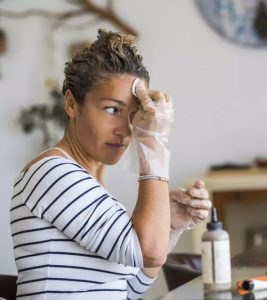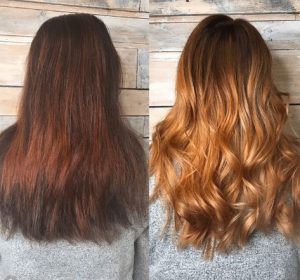Removing unwanted hair dye can be frustrating, but there are safe and effective ways to lighten or remove hair color at home. Here, we’ll explore various methods suitable for different hair types and dye permanency. Remember, patience is key! Significant color removal may require multiple treatments.
Understanding Hair Dye
There are two main types of hair dye: permanent and temporary.
-
Permanent hair dye alters your natural hair color. It works by opening the hair cuticle, depositing color pigments, and then closing the cuticle.
-
Temporary hair dye coats the hair shaft without changing its natural structure. Temporary dyes come in various forms, like rinses, sprays, and masques.
The removal method you choose will depend on the type of dye used.
Safety First!
Always prioritize safety when removing hair dye:
Strand test:
Before applying any product to your entire head, do a strand test on a hidden section of hair. This helps identify potential allergic reactions or unexpected color changes.
Avoid harsh chemicals.
Strong chemicals can damage your hair. Stick to gentle methods whenever possible.
Gradual approach.
Removing dye is a process. Be patient and avoid stripping your hair with harsh treatments.

Removing Temporary Hair Dye
Temporary hair dye is designed to wash out gradually. Here are some methods to accelerate the process:
- Clarifying shampoo: This type of shampoo removes product buildup and can help fade temporary dye. Use it according to the product instructions.
- Baking soda paste: Mix baking soda with water to create a paste. Apply it to your hair and leave it on for 15-20 minutes. Rinse thoroughly.
- Dish soap: Believe it or not, a small amount of gentle dish soap can help remove some temporary dyes. Lather it in your hair and rinse well. However, avoid using dish soap frequently as it can be drying.
Removing Semi-Permanent Hair Dye
Semi-permanent dyes last longer than temporary dyes but are not as permanent as permanent dyes. Here are some methods for removing them:
- Frequent washing: Washing your hair more often with a gentle shampoo can help fade semi-permanent dye gradually.
- Vitamin C: There are anecdotal claims that mixing equal parts of vitamin C powder with shampoo can help fade hair dye. However, research is limited. Do a strand test first and be aware that vitamin C can be drying.
Important note: Avoid using bleach or developer to remove hair dye at home. These can be very damaging to your hair.

Considering Professional Help
For stubborn dye or significant color changes, consult a professional hairstylist. They have the knowledge and experience to remove dye safely and effectively, minimizing damage to your hair.
Here are some reasons to consider a professional:
- Removing permanent dye: Professional colorists can use color removers formulated to break down permanent hair dye without damaging the hair shaft.
- Bleaching: Bleaching can be a risky process at home. Professionals can bleach your hair safely and achieve the desired level of lightness.
- Color correction: If your at-home dye removal results in uneven color or brassiness, a professional colorist can help correct it.
Removing hair dye at home requires patience and a gentle approach. By following these tips and prioritizing the health of your hair, you can achieve your desired results. If you’re unsure about any method or have significant color changes in mind, consulting a professional hairstylist is always the safest option.

Revitalizing Your Hair After Dye Removal
Removing hair dye, especially semi-permanent dye, can leave your hair feeling dry or brittle. Here are some aftercare tips to keep your hair healthy and strong:
-
Deep condition. Deep conditioning treatments replenish moisture and strengthen hair strands. Look for products formulated for color-treated hair. Apply deep conditioner according to the product instructions, typically leaving it on for 20-30 minutes.
-
Minimize heat styling. Avoid using hot tools like straighteners or curling irons as much as possible. If you do need to use heat, apply a heat protectant spray beforehand and use the lowest heat setting possible.
-
Air dry whenever possible. Skip the blow dryer and let your hair air dry naturally whenever you can. This helps minimize heat damage and allows your hair to retain moisture.
-
Gentle brushing. Use a wide-tooth comb or detangling brush to gently remove knots and tangles. Brushing too harshly can damage hair, especially when it’s wet and more fragile.
-
Healthy diet. Eating a balanced diet rich in fruits, vegetables, and whole grains provides your hair with the nutrients it needs to stay healthy and strong.
Adding Moisture Back to Your Hair
Here are some additional tips to add moisture back to your hair after dye removal:
-
Leave-in conditioner. Apply a leave-in conditioner to damp hair after showering. This helps lock in moisture and keep your hair hydrated throughout the day.
-
Hair masks. Use a hair mask once or twice a week for an extra boost of moisture. Look for masks formulated with ingredients like avocado, coconut oil, or shea butter.
-
Apple cider vinegar rinse. Mix one tablespoon of apple cider vinegar with one cup of water. After shampooing and conditioning, rinse your hair with this mixture and then rinse again with cool water. Apple cider vinegar helps balance hair’s pH and adds shine.
Natural Hair Care After Dye Removal
Removing hair dye, especially semi-permanent dye, can leave your hair feeling dry or brittle. Here are some aftercare tips to keep your hair healthy and strong using natural methods:
-
Deep condition. Deep conditioning treatments replenish moisture and strengthen hair strands. Look for products formulated for color-treated hair or try natural alternatives like:
- Avocado hair mask: Mash a ripe avocado and apply it to your hair. Leave it on for 20-30 minutes and rinse thoroughly.
- Coconut oil treatment: Massage coconut oil into your hair and scalp. Leave it on for 30 minutes to an hour and shampoo to remove.
-
Minimize heat styling. Avoid using hot tools like straighteners or curling irons as much as possible. If you do need to use heat, apply a heat protectant spray beforehand and use the lowest heat setting possible.
Conclusion
Removing hair dye is a process, and it’s important to be patient and gentle with your hair. By following these aftercare tips, you can help your hair recover from dye removal and keep it healthy and strong.
Remember, consulting a professional hairstylist is always the safest option for significant color changes or stubborn dye removal. They can assess your hair’s condition and recommend the best course of action to achieve your desired results without compromising the health of your hair.


